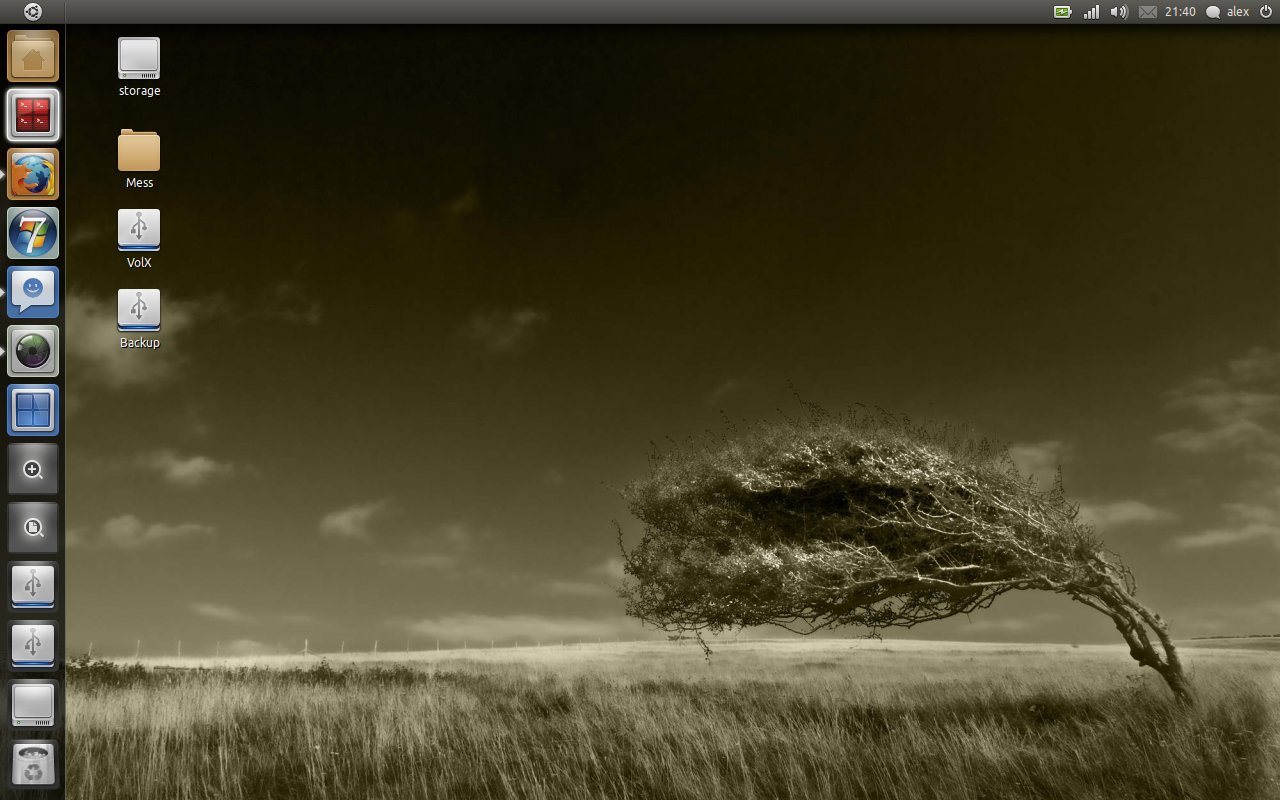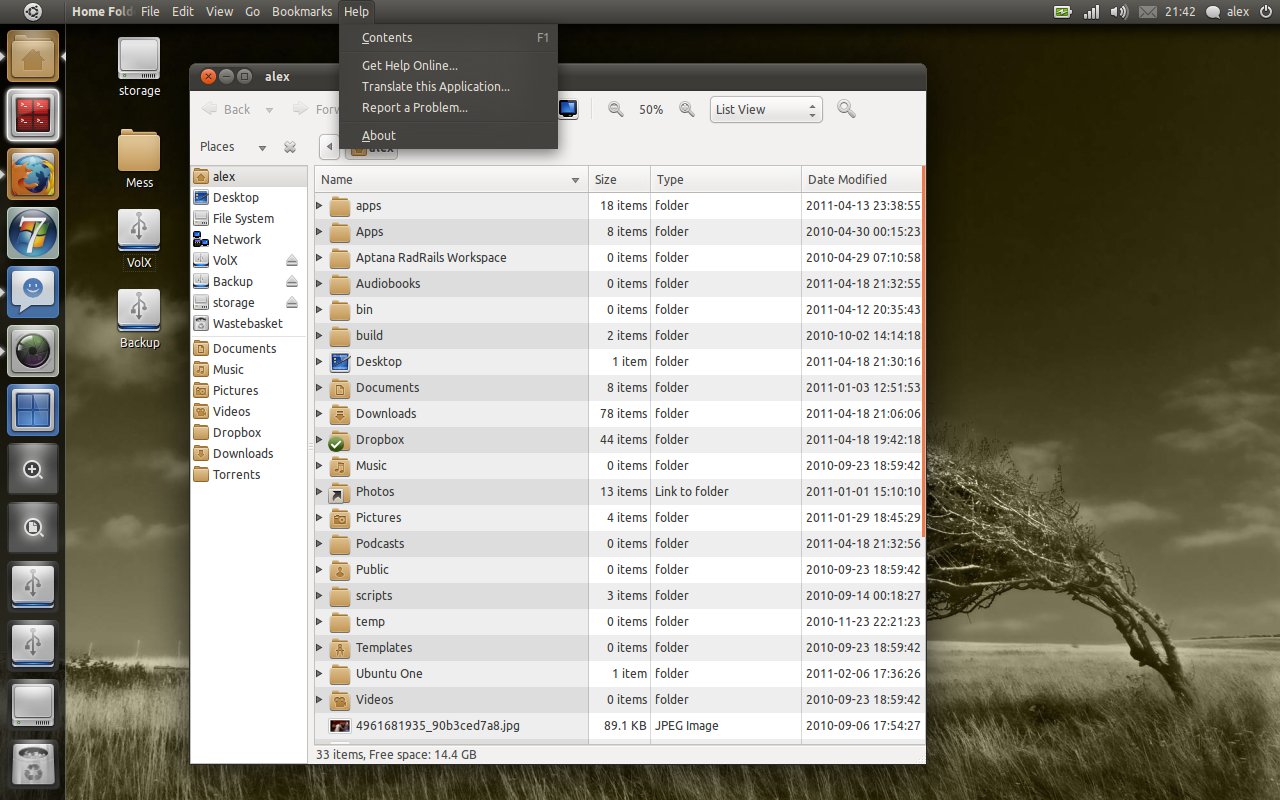I usually jump on the latest Ubuntu release before it hits the final release stage, but this time it was with a bit more trepidation than usual. You see they’ve replaced the shell with a completely new one – Unity. And to say that not everyone likes it would be a minor understatement.
The good news is that Unity is undoubtedly a step forward in practical user interface terms. The classic Gnome panel is really showing its age, and doesn’t lend itself to wide screen formats due to having panels on both the top and bottom of the screen. SUSE addressed this by created a start menu like launcher, but it was always a bit clunky and barely an improvement over Windows XP.
So how is Unity different? It is perhaps more informative to talk about how it is similar…
The first thing you notice is the panel on the left – this does bear some resemblance to Mac OSX’s dock and various dock applications for Linux such as AWN and Docky. However it is definitely not as customizable. Launching applications is an inferior experience to both OSX and Windows 7 – there’s little in the way of visual feedback that your command has been acknowledged and I have found myself clicking multiple times.
Mimicking Windows – snappy edges
Enabling this in compiz was an annoying complex hack, Unity does it by default – just drag the window to the left or right of the screen and it will fill that half. Drag it to the bar up the top (I hesitate to call it a task bar), and it maximises. It was a good idea in Windows because it’s so intuitive and I’m glad to see it here, even if it isn’t an original idea.
The windows key now behaves more like it does in windows – pressing it brings up the app launcher and it is also used for shortcut keys.
Speaking of shortcuts – the important compiz shortcuts are there – ctrl + shift + arrows to move the active window between desktops. Winkey+W brings up an expose-like overview of all open windows. You can use the arrow keys to select a Window but they need more highlighting as it’s not immediately obvious which one is selected.
For more shortcut keys see http://www.ubuntugeek.com/list-of-ubuntu-unity-keyboard-shortcuts.html.
Mimicking OSX – application menus
Basically menus behave like OSX. I don’t think people will have any trouble figuring this out, if anything it’s simply a more efficient use of screen real estate which I’m all for (my primary computing device is a 13″ laptop @ 1280×1024). They don’t show unless you hover over or press the alt key, but he general consensus seems to be that this style of menu should go away so de-emphasizing them is probably a good move.
Desktop switching – still better than the rest
Previously I’ve always used a 2×1 layout for virtual desktops. Gnome2 desktops traditionally had a 4×1 layout, I just reduced that to 2 because I don’t like hunting for my windows, and switching from desktop 1 to 3 (or 2 to 4) takes two steps. The 2×2 layout however has me sold – I find it much easier to remember where I placed a window, and while it might be just as many key presses to go from 1 to 4 or 2 to 3, mentally it’s more like 1 step.
This is because you can switch from top left to bottom right very quickly – holding down ctrl and pressing down, right is much faster than ctrl + right, right.
The Bad
It’s not all roses.
- There is no intuitive quick way to see what windows are open at a glance. In Windows 7 the taskbar is always visible, in Unity if you have an application maximised it is not. For small screens this is an acceptable trade off, for large it’s just annoying. I haven’t found a way to change this behaviour, but to be fair I didn’t look long. Winkey+W is your friend.
- Stability. I’ve encountered two crashes of the shell already, and I’ve only been using it for a few hours. Yes it’s still beta… but this close to release I’d be surprised if there’s any material difference in the final.
Verdict
I’m quite positive about it. It’s certainly a step forward, and borrows some of the better ideas from Windows, OSX and previous Linux desktops. And while it might be a bit rough, it’s early days and anything would be better than sticking with the existing Gnome2 panels.
The obvious comparison is Gnome3. The two desktops are quite different but they would do well to borrow more of each others’ ideas. I like how moving the mouse to the top left in Gnome gives you the window layout and application launchers, on Unity it only reveals the launcher bar. Gnome3 also seems a bit smoother and snappier on my machine, but sticking with what appears to be the same legacy systray seems a bit 1995.
Give me Gnome3’s smoothness and app launcher, Unity’s notification area and desktop switching and KDE4’s flexibility (while retaining sensible defaults), and we’ll have a winner.
Personally I’ll be sticking with Unity. It’s good to see innovation on this front even if it is a bit painful in the short term.





Just having a play with it now… So far, I agree on the whole. Interestingly, if you’re in the bottom right hand desktop you can ctrl + alt + left + up to get back to the first desktop instantly, but to go back you must ctrl + alt +right, down – kinda inconsistent.
I noticed that, and figured it was because pressing them at the same time doesn’t work, hence why I noted ctrl + alt + right, down rather than ctrl + alt + right + down. But now that I think about it you might be right.
Fixed in the final release – you can now navigate diagonally :)
In other news, vino-server is broken, and freeNX doesn’t work with the unity environment.
Cool :)
Bummer about vino-server and freenx but fortunately I don’t use either of those personally.
One months testing and I’m rolling back – bug fixes are too slow, any intense disk IO and nautilus just dies. Network speeds are an absolute dog compared to Windows 7, less stable and it kept dropping connections with all the devices on my network. Since all my files are on my file server – that’s a problem lol.
I’ll try again in 6 months lol. How’re you finding it?
Oh yeah hardware is
GA-Z68-UD4-B3
i7 2600k
8gb ram
Intel 320 series 120gb SSD
MSI HD5870
Boots in about 15-20 seconds flat from on button to useable desktop. apps load instantly but anything to do with the network or large amounts of files and the thing is slooooow.
Just rolled back. Same issue… Might be an incompatibility with the z68 chipset? Networking is just death. It struggles to pull 100kb/s from a LAN PC.
No problems at all. I’m using it on my work PC which is a Core i3, auth’d against a Windows 2008 DC with Likewise and it’s been a dream.
Laptop has had a few stalls but nothing a quick restart of gdm couldn’t fix.
Both my laptop and work PC are much more common lower-end hardware than yours though.
Oh and erm… Z68 was released a fair while after the current kernel version by the way. So I can’t say I’m that surprised.
Would expect it to work with P67 but try 11.10 or a current dev kernel for Z68.